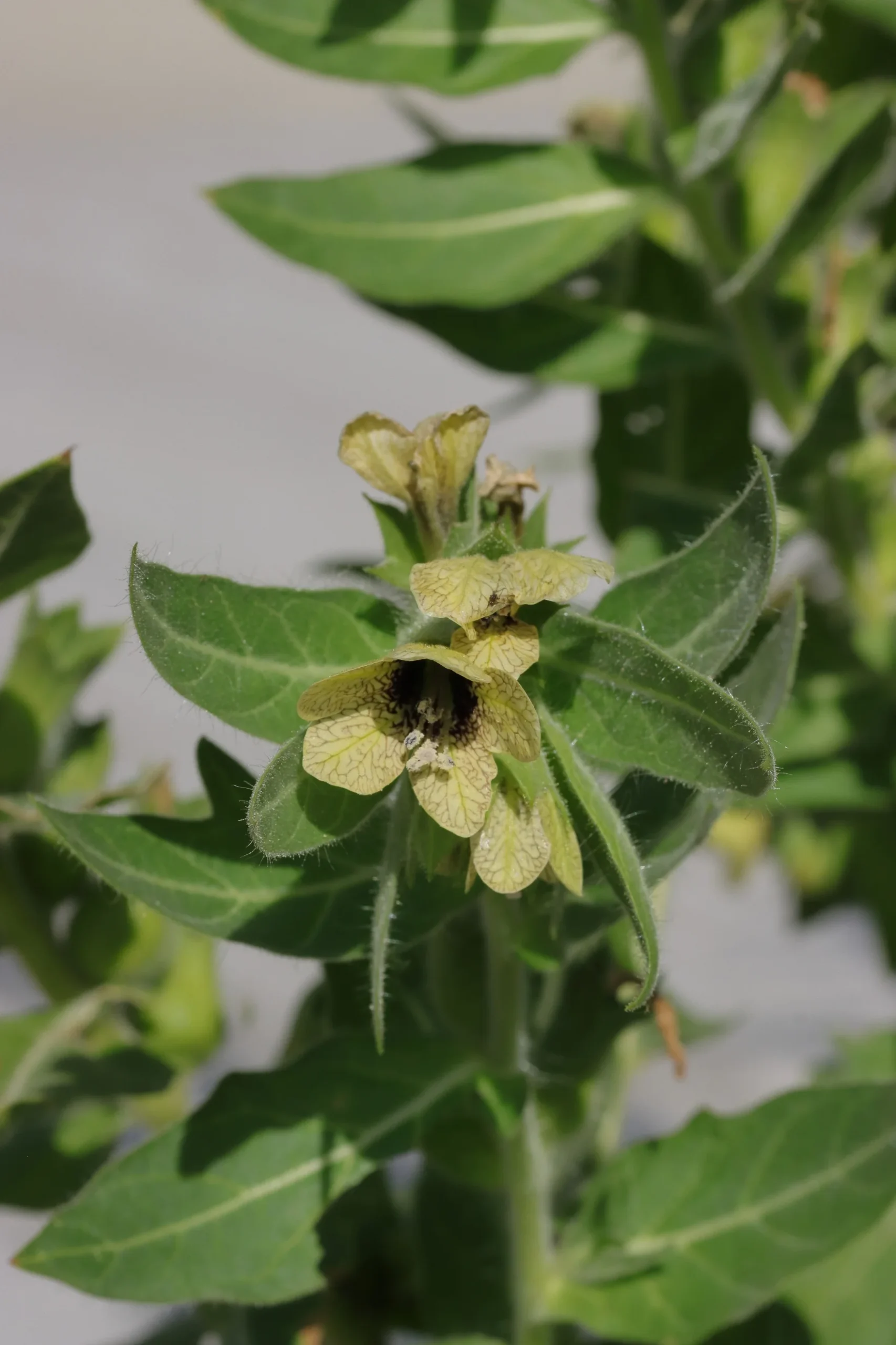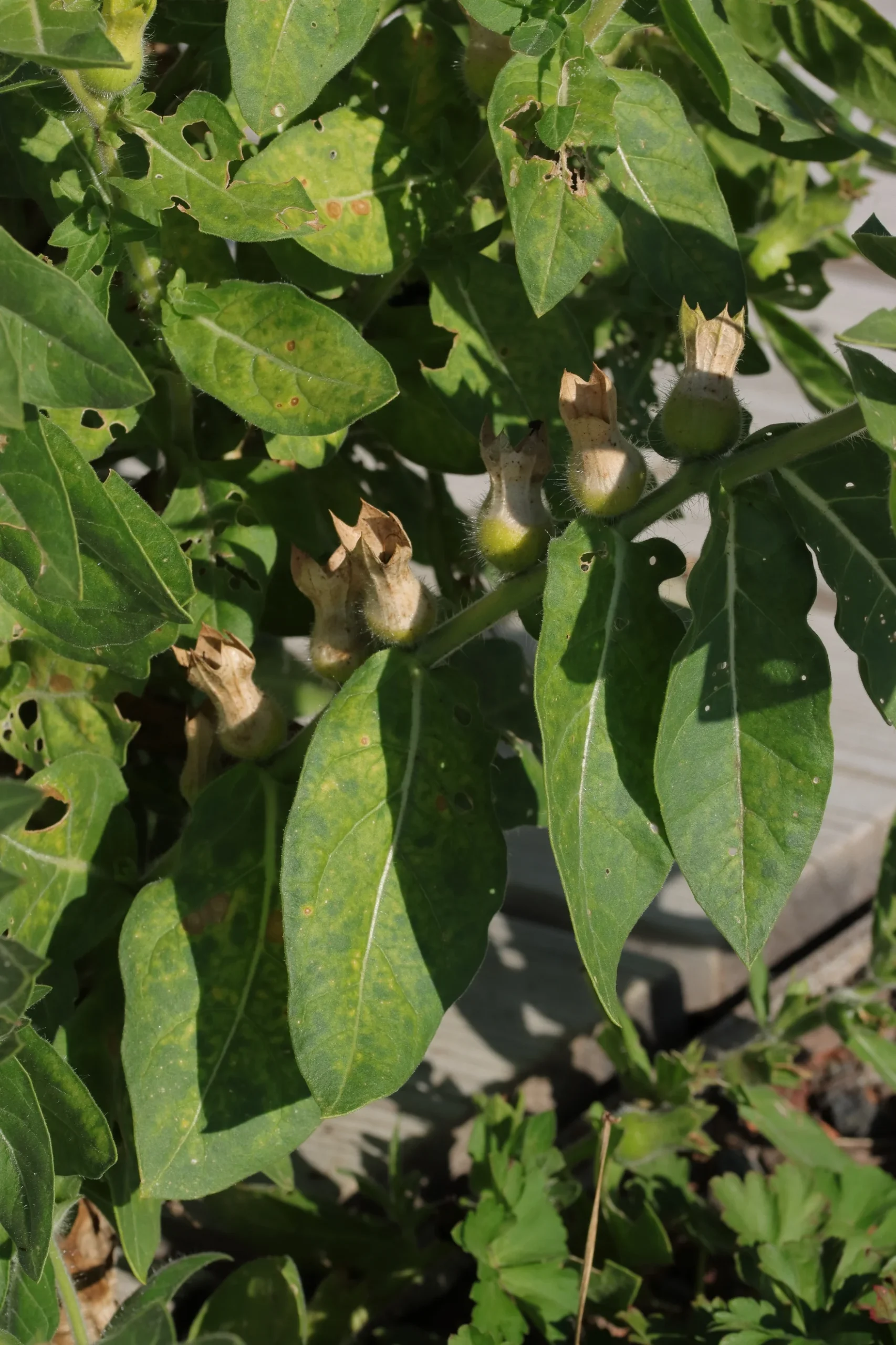11 Minuten Lesezeit
Black henbane is one of the most dangerous nightshade plants in our native flora. In the Middle Ages, the herb was a popular part of the “witch ointment”.




Occurrence and distribution: Black henbane grows on meadows, along paths and walls as well as on rubble and ruderal areas. It requires a very nitrogenous soil. It is rarely found in the wild. The plant is widespread throughout Europe.
Plant description
Growth form: The black henbane grows upright and can reach a height of between 40 and 80 cm (1 ft 3 in to 2 ft 6 in) – more rarely up to one metre! (3 ft 3 in). A turnip-shaped root forms underground. The stem is covered with sticky, shaggy hairs. It often has a simple structure, more rarely it is slightly branched in the upper part. The entire plant gives off an unpleasant odour. It is considered an annual to biennial plant and is thus only partially overwintering.
Leaves: The basal leaves have an longish stem whereas the stem leaves are close to the stems. The upper side of the leaves is grey-green to dark green. On the edges of the leaves they are wavy and have one protruding “tooth” per leaf half. The leaf edges are also covered with short hairs. The leaves are sticky to the touch.
Flowers: The flowers are in an exclusively one-sided inflorescence. The individual flowers consist of bell-shaped petals that have grown together. Five petals form per flower. They have a dirty yellow colouring and at the same time are streaked with purple veins. The centre of the flower is also coloured dark purple to black. Sepals surrounding the neck of the flower are green. The stamens are white and the anthers are black. They reach a size between 1.5 and 2.5 cm (0,6 in to 1 in).
Fruit: Black henbane forms a fruiting pod after the flowering period. This consists of an egg-shaped capsule. As soon as the capsule is ripe, a small lid opens and releases the seeds. Up to 200 seeds can form in the two-fanned capsule. The individual seeds look similar to poppies and are gray in color when fully ripe.
Poisonousness of the plant – Advice for handling
Handling advice: Contact with the sap of the plant should be avoided at all costs. Even these are toxic parts of the plant. Gloves should be worn in any case when removing the plant.
Poisonousness of the plant: All parts of the black henbane are highly poisonous! Especially the roots are among the most poisonous parts of the plant. Only rarely do people knowingly get poisoned by the plant. It is often confused with other garden plants such as black salsify before flowering. The production of so-called “witches ointments” and other preparations from any parts of the plant are strongly discouraged! Black henbane can lead to death!
Poisoning with the black henbane
Effect of the plant: The ingredients have a parasympatholytic effect on the peripheral nervous system (all nerves apart from the central nervous system). Ingestion of larger quantities of plant material can lead to an energising or paralysing effect on the central nervous system. The atropine causes a receptor blockade by displacing the acetylcholine. Common symptoms include warm, red skin, dry mouth and hallucinations. There are also dilated pupils, an accelerated pulse and also cardiac arrhythmias. Other symptoms include restlessness, delirium, raving madness, somnolence and seizures.
Contents: L-hyoscyamine, scopolamine, atropine (D,L-hyoscyamine) – above ground parts: 0.13%, seeds: 0.05% to 0.3%, roots: 0.08%.
LD for horses: A proven lethal dose for horses is 180 to 360 g of fresh or dried plant material per animal. Care should therefore always be taken to ensure that the plant does not grow in the vicinity of stables! An LD50 for humans cannot be found in the literature, but it will be significantly lower due to the lower average body weight. Minimum toxic dose: 5 mg alkaloids!
First aid in case of poisoning: In case of poisoning, go to hospital immediately! First aid can be given by administering medicinal charcoal. However, poison removal should under no circumstances be carried out by a layperson!
Treatment of poisoning: Primary poison removal should be ensured by administration of medicinal charcoal. The further symptoms can be suppressed by symptomatic therapy options. ICU monitoring may be necessary.
Former uses of the plant
Medicinal / former uses of the plant: The henbane was formerly used in the form of dried leaves as a medicinal drug against rheumatism and nerve pain. In the Balkan countries as well as in Russia, the pollen is sometimes used. It is also said to have been used in folk medicine against asthma, colic and as an narcotic. Because of the sometimes strong side effects when used, such as excitation and exhaustion with partial unconsciousness and respiratory paralysis, the herb is no longer used nowadays.
In the Middle Ages, the plant was considered an important ingredient of the so-called “witches ointments”. These ointments consist of a variety of different, partly hallucinogenic plant juices. Evidence of the famous witches ointments can be found in the ancient tales of Lucius Apuleius (around 125 – 180 AD) – “The Golden Donkey”. These were said to have helped witches to fly. Other sources also contain “tales”. Scientifically, the ointments produced led to hallucinations and ” flying experiences” when applied to the skin. There is no reliable evidence to prove whether this is actually possible. The unauthorised production and use of the old “recipes” must be strongly discouraged due to the toxicity of individual components.
In the Middle Ages, beer brewers also gave their beer a “more intoxicating effect” if they spiced it with henbane. However, the use of the plant was quickly banned because of the strong side effects!
Folk names
The black henbane is known by various german folk names. These include “Tollkraut, Zigeunerkraut, Schweinekraut, Dolldill, Teufelswurz, Schlafkraut”. An approximate translation can be “mad weed, gypsy weed, pigweed, intoxication dill, devil’s root, sleep herb”.
- Several slightly modified folk names have developed from the german name „Bilsenkraut“ (henbane). These include „Bilsemkraut“ or „Bilsem“. The toxic effect of the plant has given it the name “Dollkraut” or “Dolldill” (mad herb / intoxication dill). There is no clear evidence of how it came to be associated with the culinary herb dill. The word “doll” was formerly used for “intoxication”. A variation of this is “Tollkraut“ – “mad herb” because the symptoms are partly similar to those of “rabies”.
- The name „Zigeunerkraut“ (gypsy herb) is said to come from the fact that the plant was used by the travelling people to perform their “magic” (for the townspeople of the time, the “gypsies” were scary). Another explanation could be the rare distribution of the plant, as it can often change its location, similar to the travelling people.
- The name „Schlafkraut“ (sleep herb) is derived from the “intoxicating, sleep-inducing effect” of the plant. The ingredients can partially induce a sleep-like state.
Origin of the botanical name
Name origin: The genus name Hyoscyamus is derived from two Greek words. These are ὖς (hys – pig) and κύαμος (kyamos – bean). There are various theories about the origin of the components of the name. These are as follows:
-> theory 1: „Schweinebohne“ (pig bean) – Since the plant was eaten by pigs, but they could die from it. The part of the name “bean” is said to have arisen from this, as the leaves of henbane have a certain resemblance to the leaves of the bean.
-> theory 2: In the german book „Die etymologie der phanerogamennomenclatur“ another possibility is a derogatory term as „Sau-Bohne“ (pig bean), because the plant has poisonous effects. A similar explanation can also be provided in the cases of the „Roß- / Hunds” (horse / dog) plants. These are often given the name suffix because they have been confused with the “real” edible herbs and plants. They are therefore considered to be “good for nothing”.
The species name „niger“ can be translated from Latin into english as „black“. This refers to the black-looking centres of the flowers and “sap stains” (dark purple veins on the petals).
Origin of the German plant name
The german name “schwarzes Bilsenkraut” (black henbane) is said to have originated from the old high German word “bilsa”. It is also assumed that the word “bilsa” has an Indo-Germanic origin. This exists with “bhel” – “translated” into english as whitish. Another origin of the name may be the “Gallic” (actually Celtic) word “belenuntia” – derived from “Belenus”, a Celtic god who was considered to be the same as the Roman god “Apollo”. The Celtic god was regarded as a sun god and was associated with the words “bright or shining”. Here a connection can be made to the colour of the flowers. -> Source: ippsch.de – Whether this is actually a correct explanation can be left up to the reader.
The English name “henbane” as well as French “Hennebane” can originally be traced back to the Normans. It is also called “Mort aux poules” in French. All these names can be traced back to the folk names “hen death / chicken death”. This is because the seeds of the plant were often pecked by chickens. However, like all other parts of the plant, they are highly poisonous.
Endangerment of the plant
Endangerment of the plant: Black henbane is already classified as endangered on the German Red List. Under no circumstances should the plant be picked or collected (due to the toxicity of the plant). Cultivars for the home garden can be purchased in garden shops. However, it is not recommended to cultivate the plant! The plant is also considered endangered in Switzerland. There it is considered fully protected according to the Bern Convention. The individual endangerment levels of the German federal states are as follows:
– Baden-Württemberg: critically endangered (status: 2)
– Bavaria: endangered (Status: 3)
– Berlin: critically endangered (status: 2)
– Brandenburg: Pre-warning level (status: V)
– Bremen: critically endangered (status: 2)
– Hamburg: Threatened with extinction (Status: 1)
– Hesse: endangered (Status: 3)
– Mecklenburg-West Pomerania: n/a
– Lower Saxony: critically endangered (status: 2)
– North Rhine-Westphalia: critically endangered (status: 2)
– Rhineland-Palatinate: endangered (Status: 3)
– Saxony: endangered (Status: 3)
– Saxony-Anhalt: n/a
– Saarland: critically endangered (status: 2)
– Schleswig-Holstein: Threatened with extinction (Status: 1)
– Thuringia: critically endangered (status: 2)
Distribution codes: A, AV, M1, M2, F, K